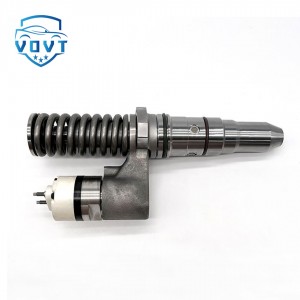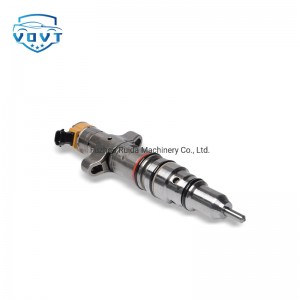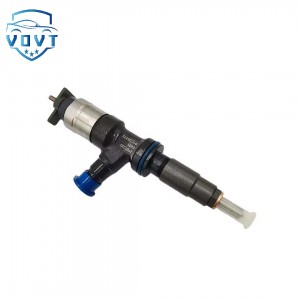New High Quality Diesel Injector 212-3463 10R-0963 10R-9235 212-3466 10R-0968For CAT C12
Products Description
| Reference. Codes | C12 |
| Application | C12 |
| MOQ | 4PCS |
| Certification | ISO9001 |
| Place of Origin | China |
| Packaging | Neutral packing |
| Quality Control | 100% tested before shipment |
| Lead time | 7~10 working days |
| Payment | T/T, L/C, Paypal, Western Union, MoneyGram or as your requirement |
Study on Mesoscopic High-Pressure Injection and Spray Characteristics of Each Hole of Diesel Engine Injector
In the efficient operation mechanism of diesel engines, fuel injectors play an extremely critical role. As the core component of the fuel injection system, the mesoscopic high-pressure injection and spray characteristics of each hole of the fuel injector have a decisive influence on the combustion efficiency, power output and pollutant emissions of the diesel engine.
The mesoscopic multiphase flow inside the diesel engine injector presents extremely complex contact dynamics characteristics. The inner surface characteristics of the parts in close contact with the fuel in the fuel injector, such as surface roughness and microtexture, will significantly affect the flow state of the fuel. In advanced fuel injection systems such as high-pressure common rails, the injection pressure is usually as high as 100MPa - 200MPa or even higher. Under such a high-pressure environment, the flow behavior of the fuel in each hole of the fuel injector becomes particularly complex. When the fuel flows through the spray hole, the velocity field and pressure field inside it are unevenly distributed, and the slight difference in the inner surface of the fuel injector may cause the turbulence of the fuel flow, which in turn affects the generation and development of cavitation. Cavitation, as the process of liquid forming bubbles in a low-pressure area and then bursting, has an important role in the injection and spray characteristics. On the one hand, moderate cavitation can promote fuel breakage and atomization, and improve the spray quality; but on the other hand, excessive cavitation may lead to erosion of the spray hole surface, affect the service life of the injector, and may also cause the instability of the spray, resulting in differences in the spray characteristics of each hole.
Due to factors such as the injector structure and processing technology, even for injectors with the same nominal size, the spray characteristics of each spray hole are often different, and it is difficult to achieve high consistency. During the long service of the injector, the continuous hydraulic grinding of the high-pressure fuel will gradually change the characteristics of the inner surface of the injector. The originally smooth inner surface may become rough due to wear, which will not only increase the resistance to fuel flow, but also further aggravate the changes in the spray characteristics of each hole. These changes will eventually be transmitted to the combustion process of the diesel engine, affecting the stability and sufficiency of combustion, and then have a negative effect on the power performance, fuel economy and emission performance of the diesel engine. For example, poor spray characteristics may lead to uneven formation of the mixture, excessively rich or too thin fuel in some areas, and excessively rich areas are prone to produce particulate emissions such as soot, while too thin areas may cause incomplete combustion, reduce engine power and increase fuel consumption.
To explore these complex phenomena in depth, researchers established a roughness model that describes the mesoscopic scale, took the surface characteristics of the parts inside the nozzle into consideration, and constructed a three-dimensional model of fuel flow and a three-dimensional model of fuel spray characteristics that considers the influence of injection characteristics. With the help of these models, the influence of the inner surface characteristics of the nozzle on the fuel flow, cavitation phenomenon, injection characteristics of each hole and spray characteristics in the nozzle can be carefully studied. In terms of experiments, the momentum method is used to accurately measure the injection law and flow coefficient of each hole of the injector with different inner surface characteristics. At the same time, a high-pressure spray visualization test bench is built, which can simulate various operating conditions in the actual operation of the diesel engine, such as different speeds, cycle injection amounts and injection pressures. Through advanced technical means such as high-speed photography and laser measurement, the influence of the inner surface characteristics of the nozzle and the above-mentioned operating conditions on fuel flow, cavitation phenomenon, fuel injection characteristics of each hole and spray characteristics (including spray cone angle, penetration distance, Sauter average diameter, concentration field and other key parameters) is studied.
The research results show that after hydraulic grinding, if the inner surface roughness of the nozzle can be controlled within a very small range, the impact on the injection characteristics of each hole is relatively small. However, one of the main reasons for the differences in the injection characteristics of each hole in reality is the needle valve clearance and its force deformation and eccentric movement. During the injection process, the needle valve may deform and move eccentrically due to the combined effect of multiple forces such as the impact force of high-pressure fuel, spring force and friction force, which will cause the sealing performance between the needle valve and the valve seat to decrease, and then make the injection time, injection amount and spray shape of each nozzle inconsistent.
The in-depth study of the mesoscopic high-pressure injection and spray characteristics of each hole of the diesel engine injector provides a solid theoretical basis and technical support for the optimization design of the injector, the improvement of the manufacturing process and the overall performance improvement of the diesel engine combustion system, which will help promote the continuous development of diesel engines in the direction of high efficiency and cleanliness.





















